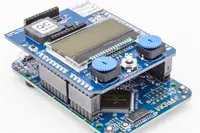Electronics News
Archive : 13 April 2015 год
 Intel is being blocked from working on the world’s largest supercomputer by the US government. The company, which had applied for a licence to export thousands of chips to update the Tianhe-2 computer based in China, was blocked by the Department of Commerce on the grounds that nuclear research could be done on the machine.
Intel is being blocked from working on the world’s largest supercomputer by the US government. The company, which had applied for a licence to export thousands of chips to update the Tianhe-2 computer based in China, was blocked by the Department of Commerce on the grounds that nuclear research could be done on the machine.
The Tianhe-2 uses 80,000 Intel Xeon chips to generate a computational capacity of more than 33 petaflops and is, according to the Top 500, an organisation that monitors supercomputers, currently the world's most powerful machine.
The machine was due to undergo a series of upgrades this year in order to boost its abilities to over 110 petaflops but the upgrade was dependent on new Intel Xeon chips. The chipmaker informed US authorities of its involvement with the upgrade programme and was told to apply for an export licence.
The US Department of Commerce said it refused Intel's application to export the chips for Tianhe-2 and three other Chinese supercomputers because the machines were being used for "nuclear explosive activities" and as a result were deemed to be "acting contrary to the national security or foreign policy interests of the United States".
In response Intel said: "Intel complied with the notification and applied for the licence, which was denied. We are in compliance with the US law."
China is now believed to be accelerating its own home-grown chipmaking efforts to boost the power of the four supercomputers and complete the upgrade programme.
In separate news Intel has signed a $200million deal with the US government to build a massive supercomputer at one of its national laboratories.
Author
Neil Tyler
Source: www.newelectronics.co.uk
 Researchers in Japan have designed a smectic liquid crystal that overcomes many of the challenges posed by organic field effect transistor materials. Crystalline organic semiconductors have attracted a lot of interest as they offer convenient low-cost fabrication by printed electronics.
Researchers in Japan have designed a smectic liquid crystal that overcomes many of the challenges posed by organic field effect transistor materials. Crystalline organic semiconductors have attracted a lot of interest as they offer convenient low-cost fabrication by printed electronics.
Development to date has been slow because of the low thermal durability and reproducibility of these materials, however, researchers at Tokyo Institute of Technology and the Japan Science and Technology Agency have been able to design a liquid crystal molecule that produces high-performance organic field effect transistors (FETs) that provide good temperature resilience and relatively low device variability in addition to high mobility.
The molecule developed by researchers can incorporate a number of qualities, in particular the smectic E phase. Low ordered liquid crystal phases form droplets at their melting temperature, but the smectic E phase has the advantage of retaining the thin-film shape.
Fabricated organic FETs can be created by spin coating a solution of their material at 110 °C before allowing it to cool. Comparison of the FET characteristics before and after mild annealing revealed a phase transition. Using atomic force microscopy the researchers identified that at around 120°C in the crystal formed a bilayer crystal phase.
The mobility of a bottom gated FET made from the material was around 12cm2Vs comparable to single-crystal devices.
"Considering that it could potentially be necessary to fabricate millions of FETs for display applications, polycrystalline OFETs may have an advantage over single-crystal OFETs," said the research team. The devices also exhibited a minimal variability of just 1.2cm2Vs, which is likely an advantage from the smoothness of the obtained film.
According to the research, "The discovery of a dramatic enhancement of FET mobility up to 13.9cm2Vs, resulting from the phase transition from a monolayer to a bilayer crystal structure in mono-alkylated liquid crystalline molecules may lead to the possibility of designing new materials for the burgeoning field of printed electronics."
Author
Neil Tyler
Source: www.newelectronics.co.uk
 Farnell element14 is become the first distributor to stock the recently launched ARM mbed IoT Starter Kit – Ethernet Edition for IBM Internet of Things Foundation. The agreement will open up opportunities for technical enthusiasts around the world looking to experiment and innovate with the Internet of Things (IoT). Available now from element14 the new development kit will enable people with limited or no experience of embedded design or web development to create IoT applications and devices.
Farnell element14 is become the first distributor to stock the recently launched ARM mbed IoT Starter Kit – Ethernet Edition for IBM Internet of Things Foundation. The agreement will open up opportunities for technical enthusiasts around the world looking to experiment and innovate with the Internet of Things (IoT). Available now from element14 the new development kit will enable people with limited or no experience of embedded design or web development to create IoT applications and devices.
Worldwide interest in IoT is high, with a recent global survey of more than 3,500 adults, commissioned by element14, revealing 43% want to be able to connect more devices and appliances to the Internet. This figure rises to 71% across China and India.
Commenting on the agreement David Shen, Group CTO at Premier Farnell, said: "The new ARM mbed IoT Starter Kit provides an ecosystem to develop IoT enabled applications. It allows designers of all skill levels to get their devices connected to the cloud and begin reading the kits sensors remotely in a matter of minutes."
"The agreement with element14 makes the ARM mbed IoT Starter Kit easily available to any developer, almost anywhere on the planet, at a price they can afford," said Zach Shelby, vice president, IoT business marketing, ARM. "A major focus for mbed is to lower the barriers to IoT innovation, enabling anyone to become an entrepreneur. This kit helps to deliver on that ambition."
The new development kit, which guides users through the processes for developing cloud-ready IoT devices, comes with an ARM mbed-enabled development board, built on the Freescale FRDM-K64F Kinetis microcontroller, which has an ARM Cortex-M4 processing core running at 120MHz. An Ethernet connection links the kit to IBM's Bluemix cloud service, which acts as a guide on how to use the board.
The kits also features a sensor expansion board, which contains a 128 x 32 graphics LCD, 256KB RAM, 1MB of flash storage, a speaker, five-way joystick, temperature sensor, accelerometer, potentiometers and a PWM (pulse-width modulation) control line to receive digital signals.
The ARM mbed IoT Starter Kit is available from Farnell element14 in Europe. Data sheets and application notes can be found on the product pages together with a range of associated accessories and 24/5 live tech support is available for any queries.
Author
Neil Tyler
Source: www.newelectronics.co.uk

